Sign up for our newsletter
Explore more

PPC: Why Your Google Ads Aren’t Working
Running your own adwords campaigns and not seeing impressions? Spending a lot bidding for keywords but aren’t sure if it’s worth it? Starting to think Google Adwords is a scam?
There’s this common belief that paid ads are easy to set up- especially because there are so many helpful tools like Google Adwords- but really, if you don’t understand the process, you’re likely wasting a LOT of money.
What does wasting actually look like with ad spend? And how do you correct it?
Below we’ll cover:
- How to measure return on ad spend (ROAS)
- Why paid ads are an investment and not an expense
- Common reasons for Google ads not showing in Chrome
- How to create top-performing ads
PPC ROI (or ROAS): How to Measure Results of PPC ads
Conversion value
ROAS = ————————————-
Cost
It can be really difficult to understand the real costs of all of your ad spend, and whether or not it’s worth it, if you’re not calculating all of your omnichannel costs at once with this formula.
Of course, you don’t solely want to rely on ROAS.
You want other Adwords data, and there are specific PPC metrics you want to keep your eyes on (and use to calculate ROI), such as:
- Cost per click
- Monthly ad spend (your budget)
- Monthly clicks of existing campaigns
- Monthly PPC impressions
- Cost per conversion
- Total number of conversions monthly
- Click-through rate (CTR)
- Quality score
- Bounce rate
- Account activity
Other key audit metrics you want to consider include:
- Initial customer value
- The lifetime value of the conversion (more on that below)
Putting all of this data into a spreadsheet can really help visualize these costs.
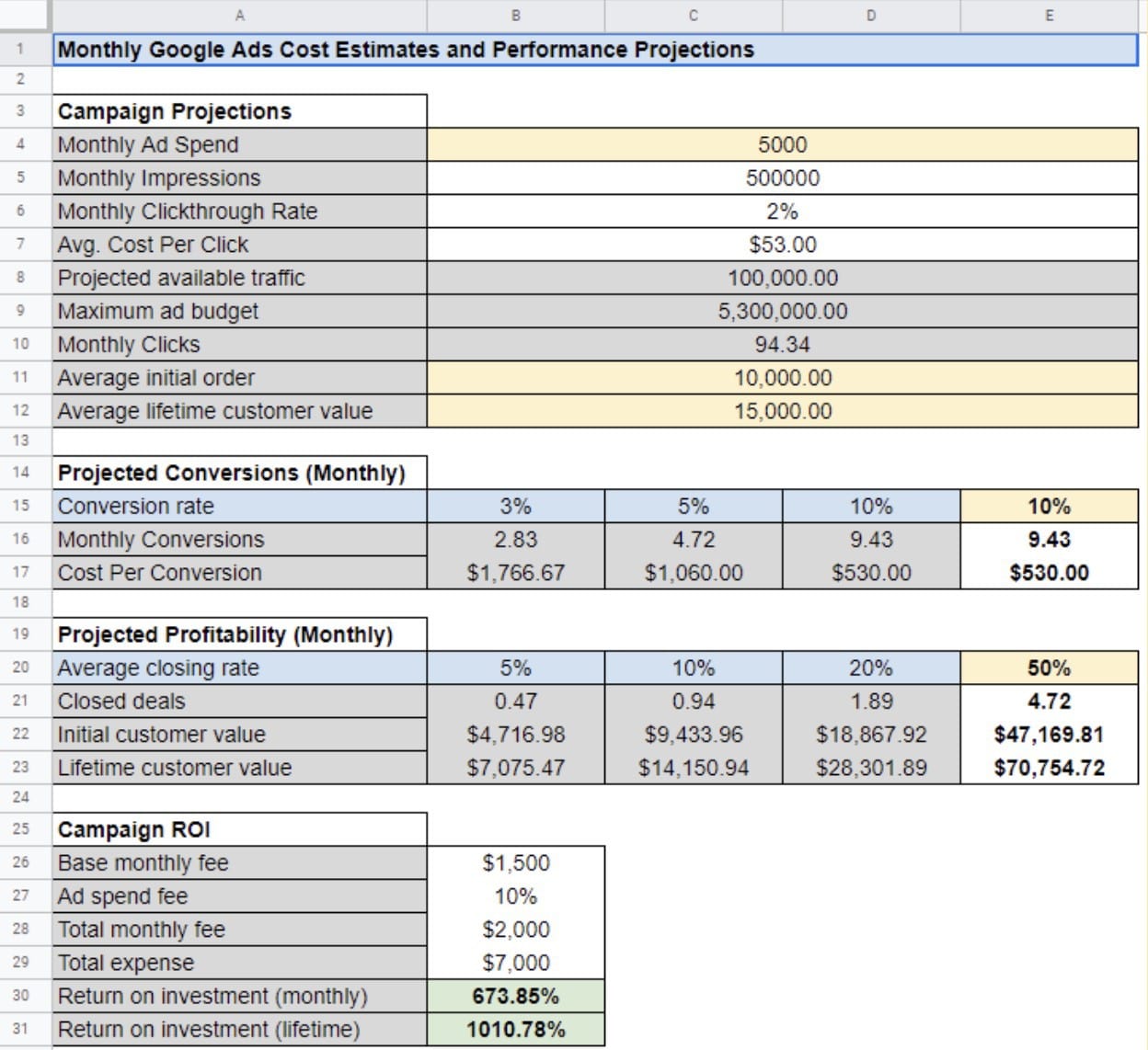
** Note: your ROI can be different from your ROAS based on how much you’re spending someone to manage your ad campaigns, so that’s something to factor in too (in the “total monthly fee” row).
Building ROAS into your PPC campaign
What’s interesting is that you can actually make calculating your ROAS a lot easier by building it into your Google ads campaign monitoring.
So, if you go into the campaigns section of your Google ads account, click on columns, and modify, you can actually create your own column.
- Google ads> campaigns> columns> modify> custom columns
- Click the little blue custom columns plus sign and you’ll see a form pop up
- Add conversion value and divide it by cost (you create this formula in the “metric” text block)
- Enter and it’ll create this column in your campaigns monitoring
Why PPC ads are an investment, not an expense
You set a monthly budget. You pay attention to your daily and monthly costs, and bidding costs of course. But do you count that as an expense?
If you do, you’re looking at your ads incorrectly. It may actually be hindering your business growth.
Consider this… A potential customer for your dental practice clicks on your ad, likes your prices, has all of their questions answered through some great content, and then sets up an appointment. They’ve converted.
But the transaction doesn’t stop there.
Say they like your dental service so much they bring the rest of their family in for cleanings, braces, retainers, and the like. Then they recommend friends to your practice as well.
And if they continue liking your services, they’ll come to you for life.
That’s potentially hundreds of thousands of dollars, all because you spent $20 on an ad.
You might feel a little hesitant to put the money out there, but you have to consider the lifetime value.
- How long do you typically retain customers?
- Do they bring family and friends?
- What is the monetary value of just one transaction?
- What is the average value in a single year?
When you realize that your leads from paid ads can contribute to the long term growth of your business, that $20, or even $200 click rate doesn’t seem as bad.
Most Common Reasons Why Your Google Ads Aren’t Working
Google ads can either be a worthy investment or a bottomless money-pit. But this isn’t on them. They’ve provided a truly worthy platform that helps your business grow.
Consider this: Google is an incredibly wealthy conglomerate that the entire world utilizes. They don’t need to scam you.
Heck, they’ll even refund you if they detect bots clicking on your ads and eating up your spend. Google is highly motivated to create the best experience possible for their customers. It’s a bit of a misnomer to think otherwise.
So don’t blame Google if your ads aren’t working, because there are literally dozens of reasons your Google ads aren’t showing or are underperforming.
These are some of the most common reasons your ads don’t show in Google:
- You’re not tracking everything properly
- There’s too much competition with the keywords you’re bidding on
- Poor budget management
- You’re choosing keywords with a search volume that’s too low
- You’re Googling your own PPC ads
- Your ad account balance is empty
- Improper bidding
- Negative keywords
Not tracking your paid ads
If there’s a lack of feedback, or data, you can’t make accurate decisions about your ads. So you just keep pouring money into them.
This is worse if you’re getting a few leads here and there from these ads. You just assume they’re working, but never really measure just how well (or how poorly).
If you’re not monitoring your ads and how they perform, you’re very likely to blow through your monthly ad budget without getting a return on investment.
Here’s the thing, everything about your ads should be trackable (if they’re set up right)
Whether the lead fills out a submission form, jumping on the phone, or gliding through your content (starting from your paid ad).
If you’re not familiar with the process, this can be really challenging.
What’s more challenging is that you can turn to an agency or even a private PPC specialist, and there’s a chance they’re not going to pay as much attention to whether or not you’re getting the most out of your ads.
They may monitor your ad spend, but if you’re not careful and don’t monitor this yourself, they may be comfortable with setting and forgetting your ads.
Ways we track PPC ad metrics and effectiveness:
It will vary by site, but in most cases, you’ll tie your paid ads to either a phone number or a form. You’ll need a call tracking script on your website to see where the leads are coming from, and also to change the phone number for every ad.
This way, a different phone number appears every time someone clicks on one of your ads. And since there’s a different phone number for every keyword in every ad group and in every campaign, you’ll be able to see which ads brought in which conversions.
To measure leads pulled in from these ads for phone leads:
- You can either go straight into your Google ads dashboard, look into each campaign, and filter by ad group or keyword. This will show you how many calls were brought in by each specific keyword and ad.
- To dive into this further, go to Call Rail (or wherever you keep your call recordings or tracking) and filter by source. You could then listen to the calls to see how many leads were generated.
To measure leads pulled in from forms:
- Slightly different, leads from forms or any other source on your website (such as a download), rely on setting up a thank you page and conversion goals. So first, you’d create a thank you page and tie all of your forms and sign ups and downloads to the thank you page. Make it the last thing they see after their action.
- Now make the thank you page a conversion goal in your Google Analytics account. Once set up, you’ll be able to see how many leads you’ve pulled in. If you want to create specific landing pages for each campaign, that could work too, if you’d like to attribute them to specific campaigns.
Too much keyword competition
You’ve done your keyword research, and have chosen a few top industry keywords to bid on. But the keywords you’ve chosen have an incredibly high CPC (cost per click). Is it really worth it?
So, we’ll discuss part of this in the section on why PPC is an investment, but I think it’s pretty important to point out that some verticals are just… higher.
Back in 2017, Search Engine Journal did a study on this and found that the most competitive ad verticals include:
- Insurance (Average CPC $29.24)
- Legal (Average CPC $45.12)
- Financial (Average CPC $24.50)
- Medical (Average CPC $21.08)
- Online college (Average CPC $31.76)
- Home services (Average CPC $25.40)
- Automotive (Average CPC $18.12)
In those industries, you can expect high competition and even higher bidding.
But your industry isn’t always the cause of higher keyword competition. Sometimes, it’s just the words you’re choosing.
Chances are, you’re using general industry keywords like “Personal injury lawyer” or “HVAC company”. If you are, expect to be pushed to the bottom of the page or to other pages unless you bid much higher than your competitors.
How to know there’s too much competition for a keyword?
There’s really no way to tell whether or not the keyword has too much competition unless you have data and can make projections on the costs and possible returns for you.
Generally, that’ll be based on what your conversion rates looked like in the past, especially for those particular keywords.
There are, of course, specific indicators that a keyword has too much competition- specifically, cost.
Remember that this is an auction. So when there are a lot of people bidding on a keyword, the costs go up.
Another way you can tell is:
- Go into your keyword planner.
- Set regions to target.
- See keywords and search volume.
- Select words and put in a plan.
- Narrow the region even more (even down to a city or neighborhood within the city.
- You can now look at the top and bottom of the page bids and see the costs and project how many bids are possible based on your past data to determine if those words are worth it.
Poor budget management
Really, this plays into the whole tracking thing… If you’re not tracking how the ads are using your spend, how many qualified leads you’re actually gaining, and where your leads go when they click on your ad, that’s poor budget management.
Too many set their ad budget, create their ads, and then don’t make any adjustments. It leads to a lot of spend with little ROI.
Your keywords have a low search volume
Keyword competition is fierce, and you can’t compete. It’s simply too expensive to go after those high volume keywords. So you opt for keywords with a much lower search volume.
This isn’t necessarily a bad strategy.
In fact, if those keywords are long tail and have a lot of search intent behind them, they might even bring in much more qualified leads (even if it’s a slower trickle).
You’re Googling your own PPC ads
First of all, if this is how you’re discovering your ads aren’t showing STOP!!!
- Your Google ads might not be showing because of the demographics set in the ad
- If you’re googling your ads frequently, Google knows that you’re the one feeding impressions and actually deactivates your ads
- If you are seeing your ads, but not clicking on them, you’re actually reducing your CTR (click through rate)
- If you do click on your ads… well, now you’re just wasting money.
If you want to see what your ads look like without affecting ad spend or CTR, use the Google Ads Preview Tool. Then you can set your demographics and do a search to see what it looks like.
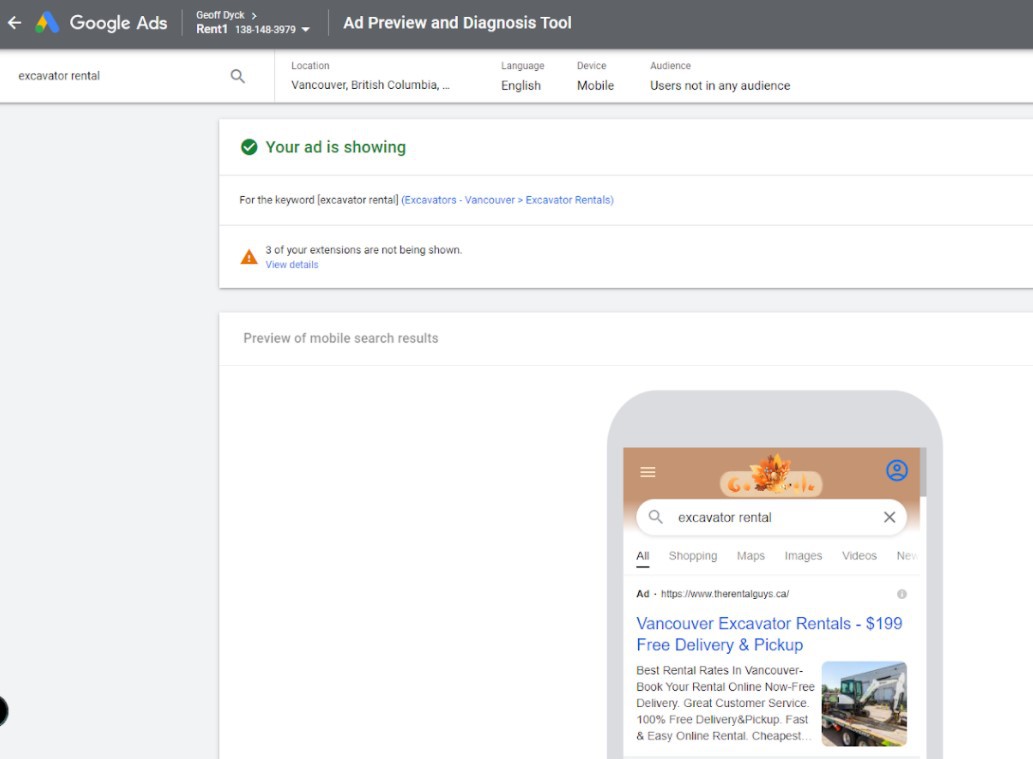
Your ad account balance is empty
Your ads are never going to appear 100% of the time. You can get close, but it’s just not possible to always appear for every search.
The largest reason for this is because you’ve run through your daily or monthly budget already, so the search engines aren’t showing it/ Google paused your ad campaign.
Here’s what it looks like…
Say you only have a daily budget of $50, but your click cost is $10.
Realistically, you can only get 5 clicks a day.
Once you burn through that budget, you’ll see that your Google ads are not showing up in Chrome or anywhere else. That’s just how it works.
You want your average click cost and daily budget to be as wide as possible, and you have to keep an eye on those costs on a day to day and week to week basis.
Most people have a demand that’s much higher than their budget or that can’t compete with the higher bidders. Since there are so few positions, Google will more likely place the other ads ahead of yours.
This may be a little more true in the beginning, since Google has to determine the best times to place your ad.
Improper bidding- too high or too low
Again with the budget.
If you’re budget is too low, but your bid is too high, of course your not going to get the bid and therefore, your ad won’t show.
On the other side, if you’re bidding too low, your ads may be running… just not on the first page (or at least not on the top of the first page).
You also have to be aware of your bid. If your budget is being consumed too fast, maybe lower your bid to aim for the third position on the page rather than the first. You may even get 2x the clicks out of your bids that way.
For smarter bidding use the budget explorer.
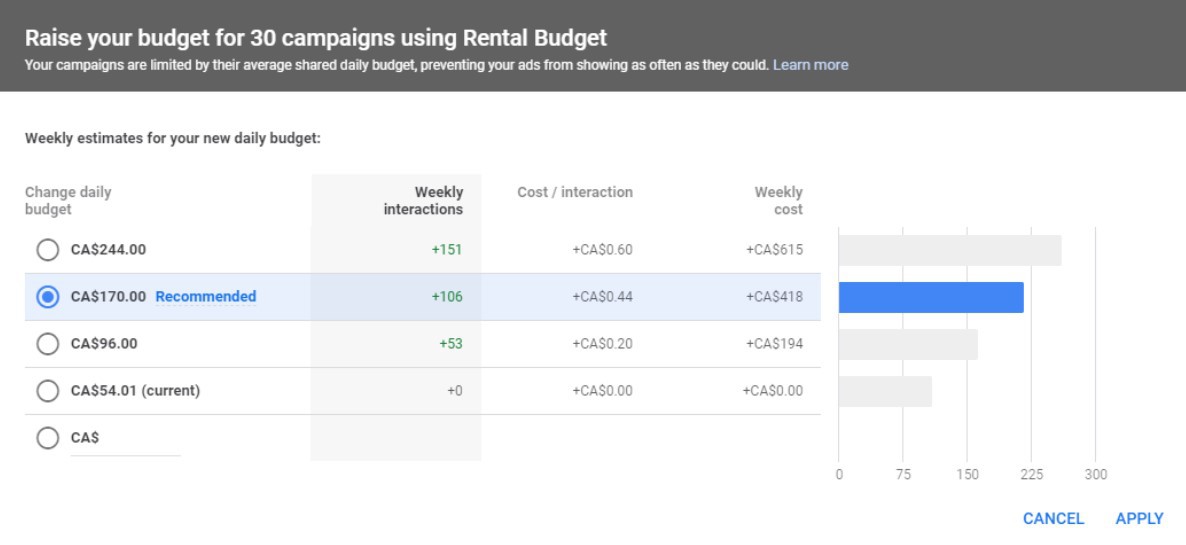
Negative keywords are canceling out active keywords
It may sound counterintuitive, but negative keywords- a list of words you don’t want your ads showing up for- are your friend. Say, for instance, you’re selling a keyword research tool, and you want to advertise a free trial for that tool.
Let’s look that up real quick…
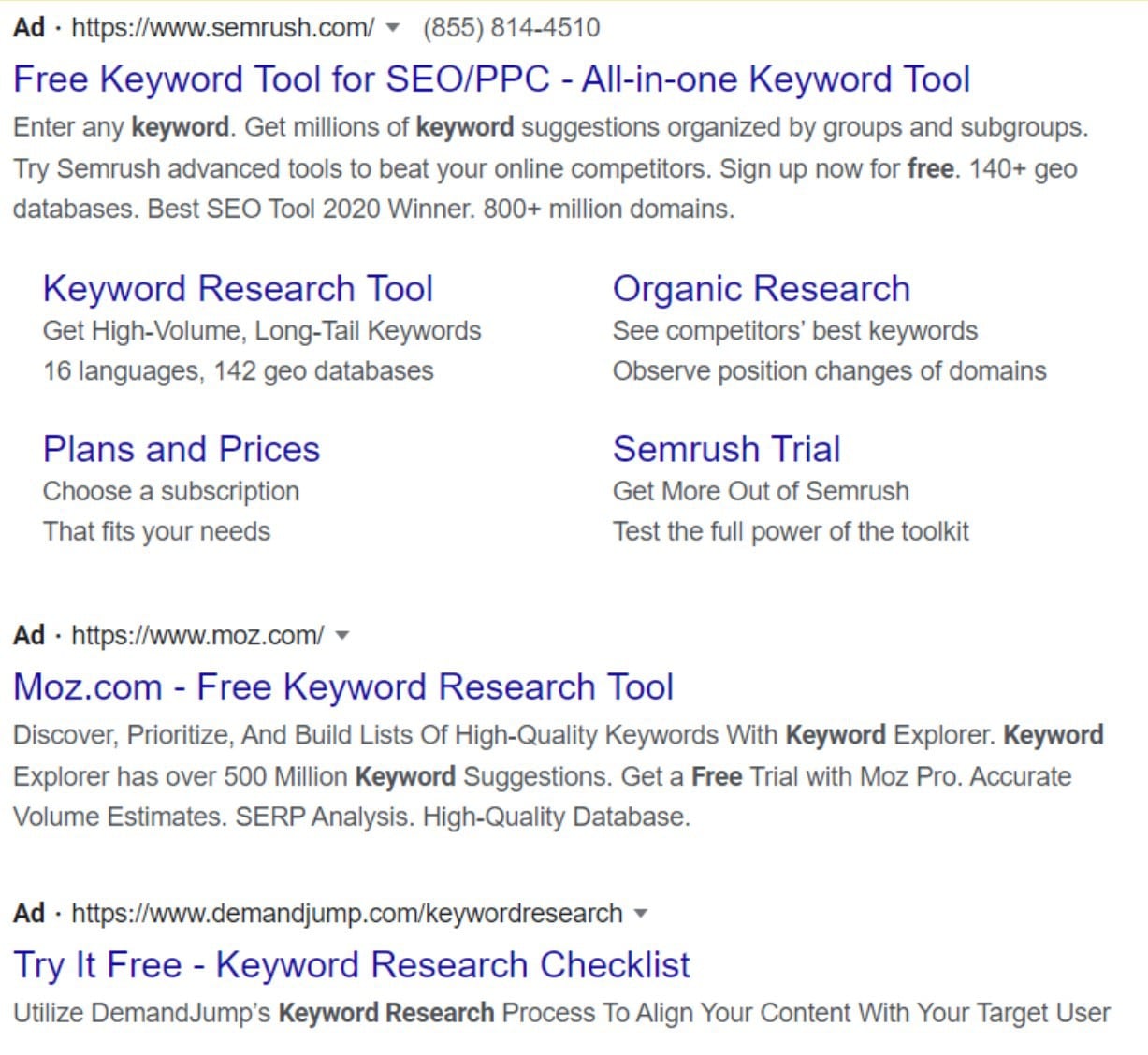
Since you’re advertising for a “free trial” of a keyword research tool, you don’t want the search engine to display your ad for “free keyword research tool”.
The intent isn’t there for the user. They want free, not temporarily free.
In such a case, you’d need to set your ad to an exact phrase match for “free trial” and ad “free keyword” to your negative keyword list.
That exact phrase match distinction really makes a difference. If you’re set to broad match, then the ad can appear for any combination or rearranged words or won’t appear at all because the negative keyword would override it.
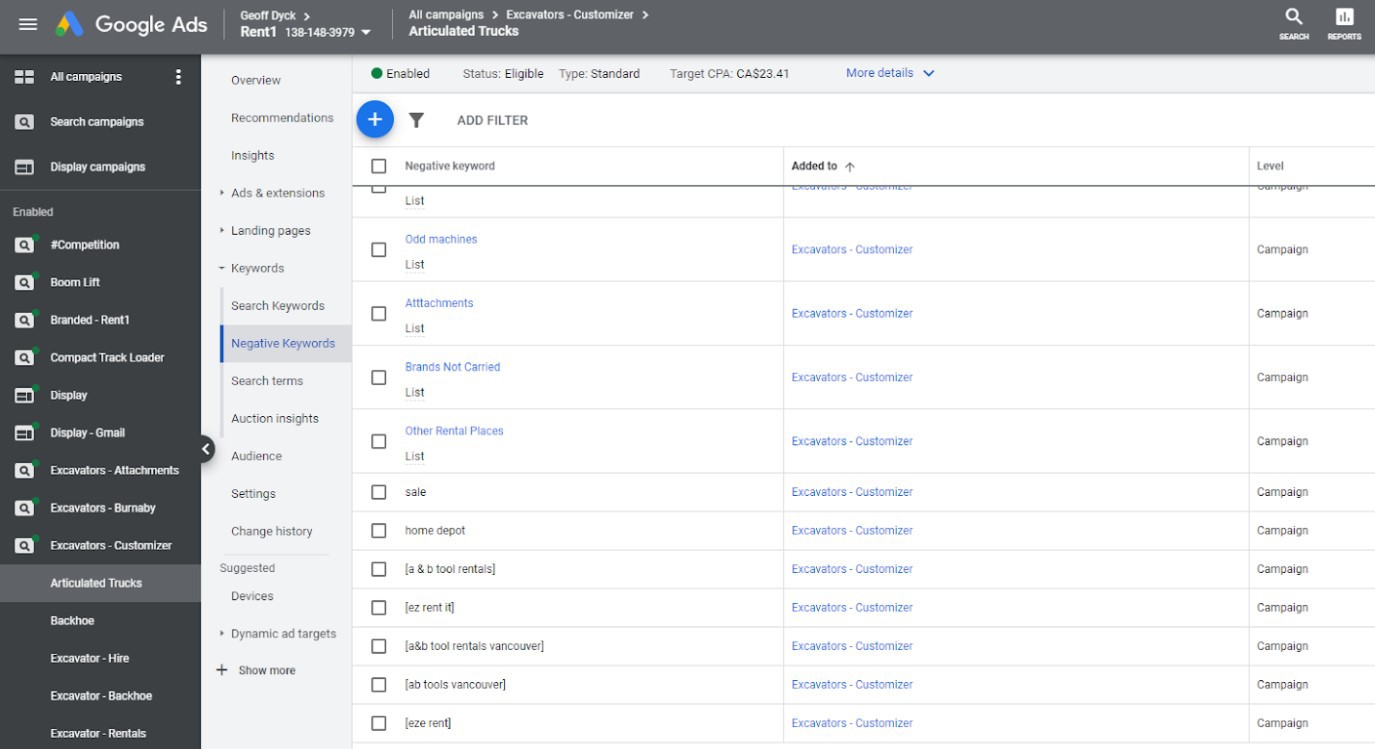
Device bidding issues
You have to configure your ads to be responsive for mobile, desktop, and tablets. You’ll still likely appear for desktop, but your ads may not appear on other devices.
Geoff: We don’t configure it baked in the system.
Why Your PPC Ads Aren’t Performing
Say you got all of the above right, but your ads still have no impressions, your bounce rate is too high, and your conversion rate is too low.
There could be a number of things going on here.
- Irrelevant landing pages
- Your content isn’t optimized
- Your demographics aren’t focused/ intent isn’t there
Irrelevant landing pages
There’s somewhat of a rule that you create specific landing pages for each ad campaign.
Why?
Because you’re meant to give people a direction and giving them too many options- such as when they land on your general website- can distract them from the end goal (conversion).
This also affects your quality score, which is, of course, impacts your cost per click.
For example:
If your keyword is “excavator rentals Surrey” and your ad says “excavator rentals Surrey” and your landing page does as well, customers are going to see that as relevant to them and so will Google.
But this doesn’t necessarily hold water for every ad campaign.
For instance, if your target audience is looking for an HVAC installer, and they click on your ad, they may want more information than just HVAC installation.
What if they want to know about your company? What if they don’t know what they need exactly?
It really depends on the use case.
That said, completely irrelevant landing pages can kill your ad conversions and dramatically increase bounce rate.
You haven’t put any thought into content optimization
This has everything to do with search intent. It’s often an afterthought for a lot of people- even the ones more familiar with running ad campaigns.
Essentially, if you’re not using keywords (the more specific the keywords the better), in your ad copy, you’re not going to show up in an organic search.
See, a search engine relates your content to query intent. If it doesn’t find what they’re looking for in your ad copy, it assumes it’s irrelevant.
Here’s what optimized ad content looks like:
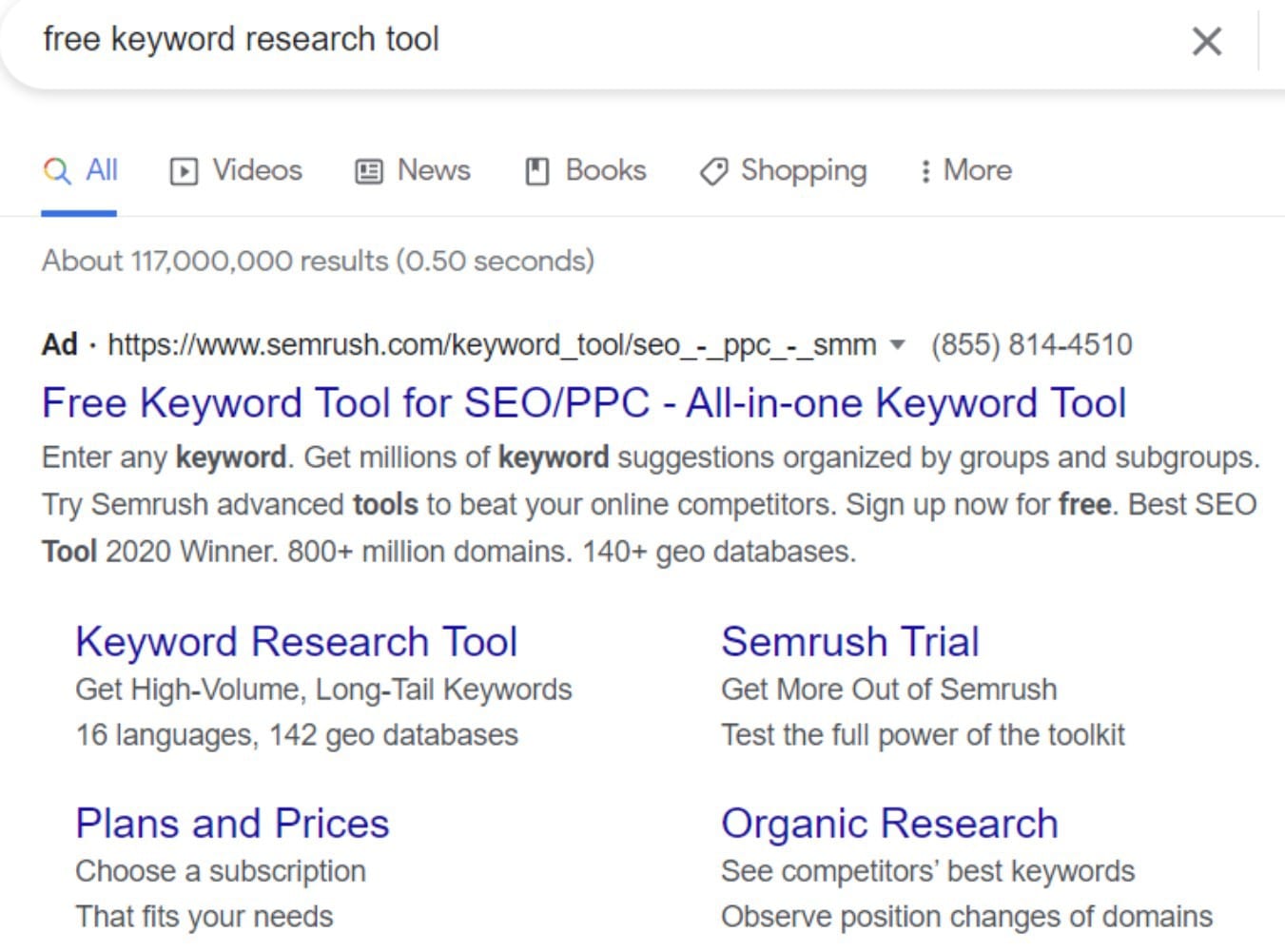
Notice that they use multiple instances of the words “free” and “keyword” and “tool”. That’s some good copy.
Not focusing on demographics
Thinking your service is for everyone is a mistake, and that applies to your ads too.
If you’re not selecting your target audience in your ads set up, you’re probably burning through a good deal of cash.
Identify your target audience, and really, I hope you already know who that is because you need it for absolutely every part of your business.
You need to know:
- Where they are
- What their job title is
- What their biggest pain points are
- What their goals are
- General demographics such as age and ethnicity

You can break down demographics by household income, gender, age, and so much more.



How to Create PPC ads on Google With High Conversion Rates
Google Adwords doesn’t have to work in a silo. In fact, it really should work in conjunction with all of your content and campaigns.
When you do this, your ads act more as touch points along a much grander plan, and work to both nurture and build trust with your target audience.
Without taking your step by step through setting up a campaign, because I imagine that you’re at least familiar with setting up ads yourself, we’ll cover the top elements to successful ad campaigns.
These are the details that go beyond normal set up, and into the more nuanced ways to get more impressions and conversions from your ads, such as (and some of these may sound familiar):
- Align the keyword, ad, and landing page
- Use ad groups
- Define audience intent
- Retargeting
Total campaign alignment
There’s only so much Google Ads can actually do for you. You could have everything with the ad set up correctly, and see a lot of clicks, but few conversions and a high bounce rate.
If this is the case, it’s likely because your landing page is one or more of the following:
- Chaotic
- Irrelevant
- Unresponsive
- Slow to load
- Written poorly
- CTAs don’t work
- There are no CTAs
We’ve touched on this in sections above, but it’s one of the biggest players in failing ad campaigns.
You can’t just set up your ads and expect it to yield results. Everything connected to it has to be on par.
Use ad groups
An ad group is a set of several ads that have the same conversion goals, but use different keyword groupings.
If you set your ad account up right, this is how it’ll be organized:
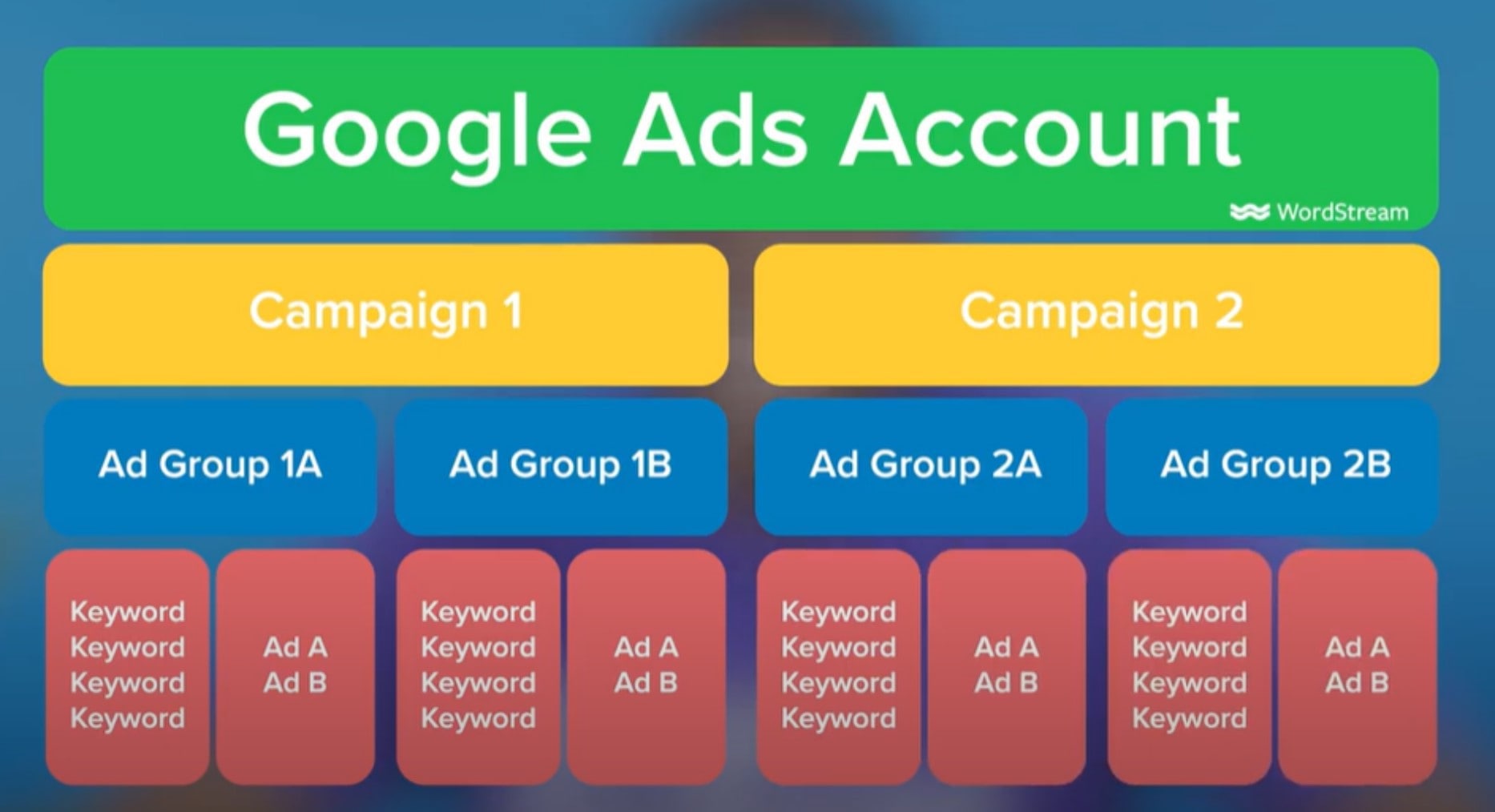
Multiple campaigns, with several ad groups containing several groupings of related keywords.
You may already have your campaigns set– each campaign is related to a particular sales goal (such as getting more people to rent Komatsu tractors for Rent1).
Within your campaign, you need to consider:
- Location targeting
- Language targeting
- Budget
- Bid strategy
After you’ve set up your campaign, you get to the ad group level.
Ad groups are generally based on a theme and control ad association.
You can create as many ad groups as you need to align with what the customer needs.
Each ad group has around 20 keywords, and you’ll likely run about 2-3 ads per ad group.
Creating an ad group isn’t a big challenge, but it’s one of the biggest mistakes we see, and generally a big miss if you’re trying to set them up yourself.
Here are the basic steps:
- Go into your campaign > ad groups
- Click on the little blue plus sign to add an ad group and click “Text ad”
- Set your ad type to standard, and create a name for the ad group based on the theme (such as komatsu tractors)
- On that same page, you can add all of the keywords for that ad group
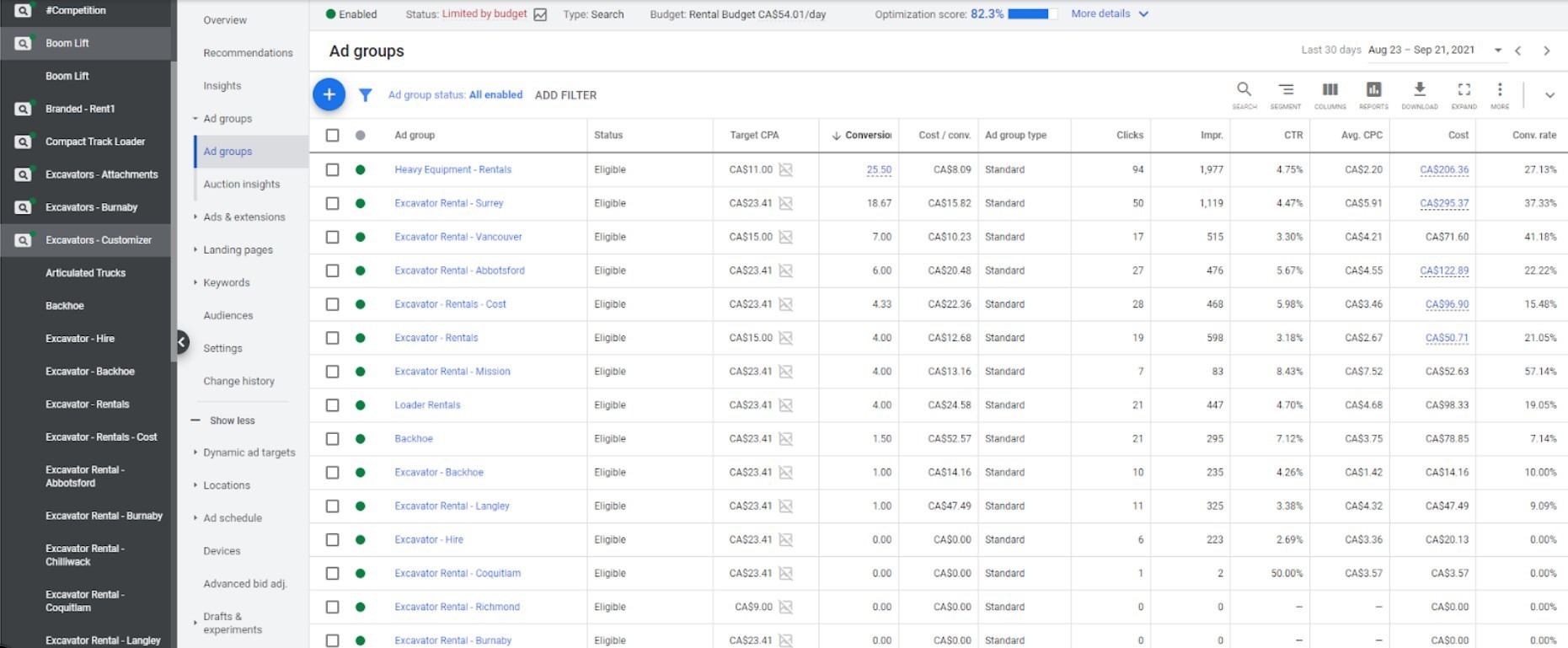
Click blue +icon
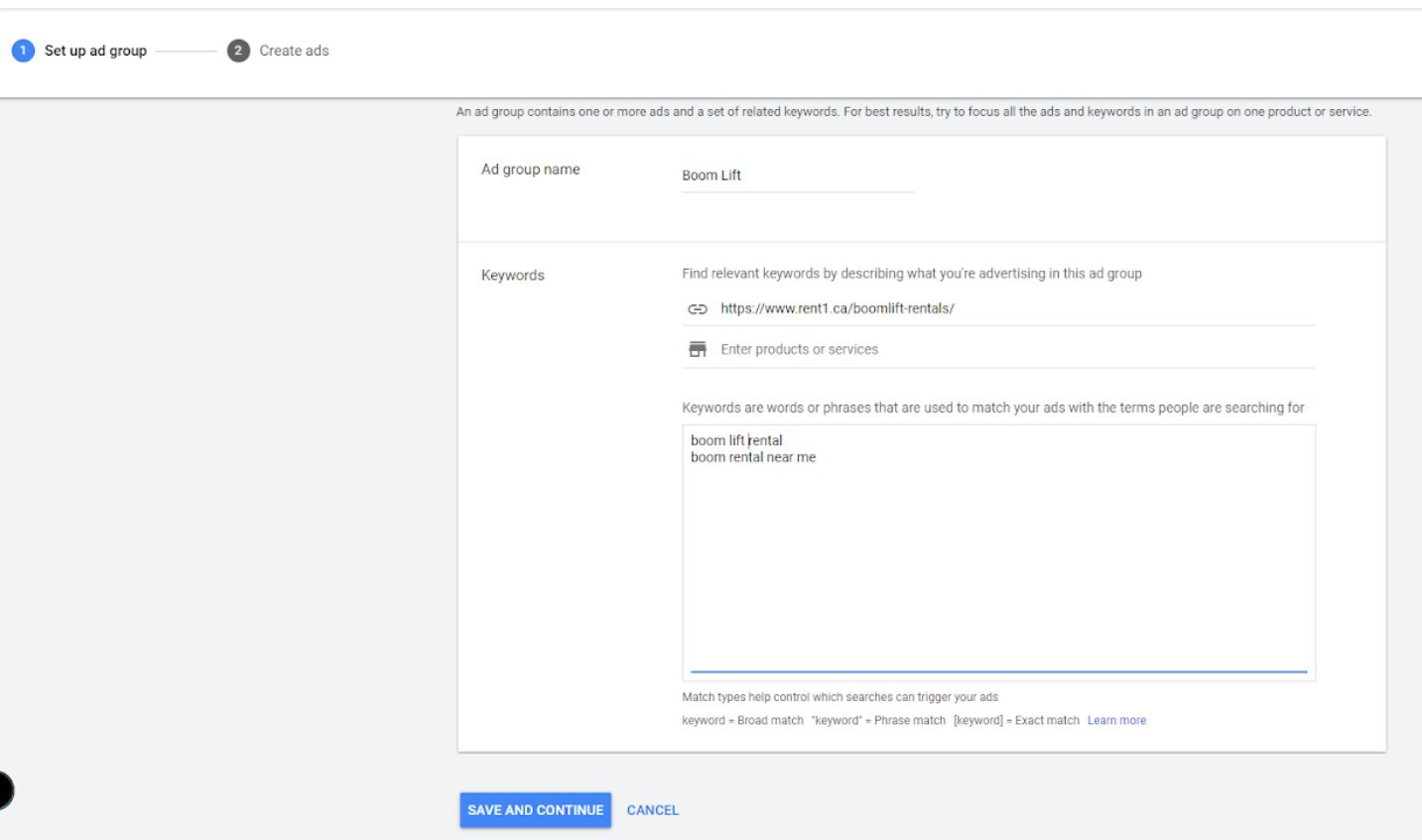
Remember that the main goal with ad groups is to focus on specific audiences with specific goals. It’s focused on a specific topic.
For example, for Rent1, we have ads specifically for excavator rentals in Chilliwack. If it was a backhoe, we’d use Backhoe + Chilliwack.
The big mistake would be to not target the areas, and group everything into one ad.
Define audience intent (selecting the right keywords for your ad groups)
Again, we’ve touched on this a little bit already, but I want to give you a bit more context.
Google Adwords automatically creates custom intent audiences based on your website, but you can create your own audiences as well.
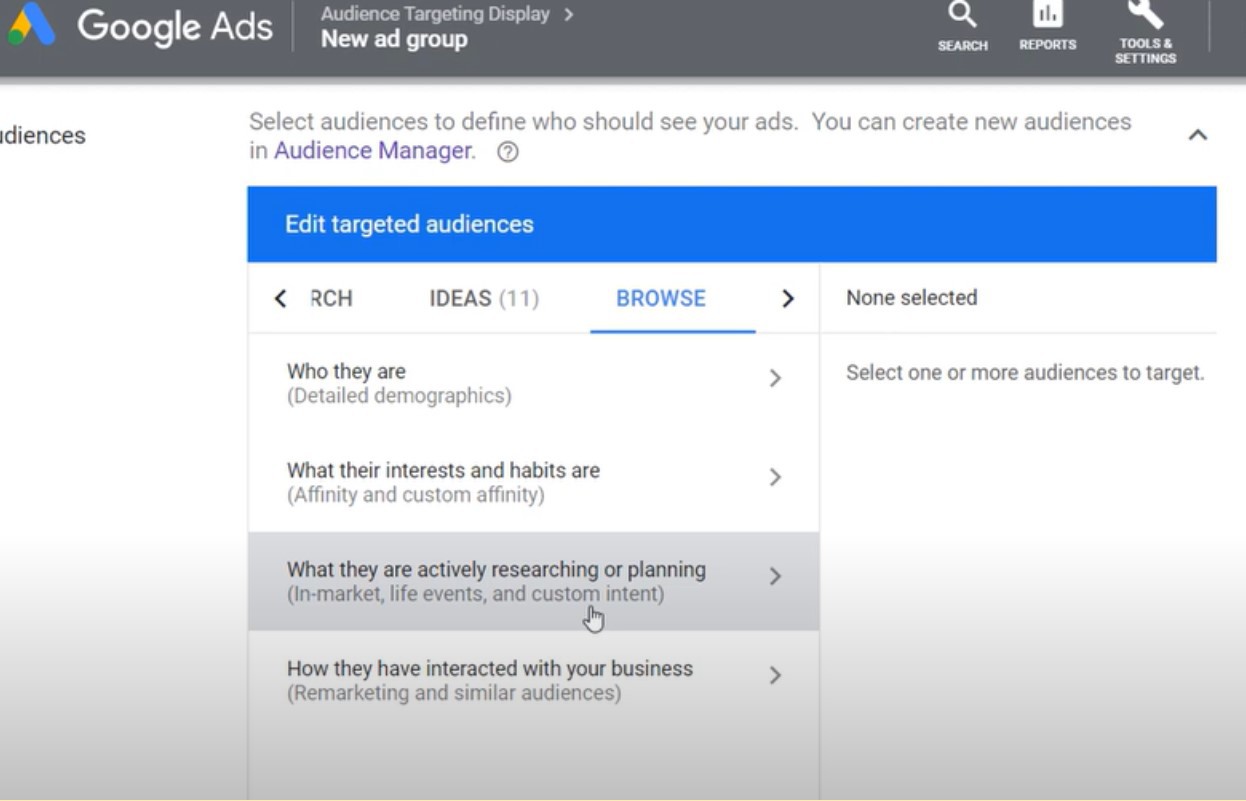
At the bottom of the browse page, you can click on create a new audience, name your audience, enter your own keywords, and keyword ideas will pop up in the side column…
What happens is, Google will define the audiences based on those terms. They’ll align you with the audiences already actively searching for them.
Simple enough, right?
The crux of it is- you have to choose the right keywords.
Yes, Google will give you ideas based on heavy related searches, but you have to do some leg work to see what terms your audience is actually typing into a search engine.
How?
- Ask your audience
- Pay attention to which keywords have worked best in past campaigns
- Search for the keywords you think will work, and see if it yields the results you think it should
- Create a spreadsheet of pain points and related keywords
That last one is generally the longest way around this, but it tends to be the most accurate and the method you can use for every other part of your marketing.

Here, you can see columns for pains, keywords, and content ideas. It’s the start of my content planning, based on audience insights about their biggest challenges in business.
When you identify a pain first , you can find the keywords that relate to what they actually need and want… what they’re searching for.
Here’s the process:
- Audience research to identify pains (usually through conversations with your audience, client facing employees, or surveys)
- Create a spreadsheet of their most common questions/ challenges
- Do a Google search using their words, or just Google their problems and see what comes up.
- In your spreadsheet, add what pops up in the related search section at the bottom of the first Google search page.
- Click on the first few pages in the search, and use a keyword tool like Ahrefs to see which keywords the page ranks for (and also, see what focus keyword they’re using just by looking at the title of the article)
- You can add the longer tail keywords that relate to the challenge your audience faces into your spreadsheet.
Now you can add those keywords to your ads campaign.
Again, this is a really thorough way of doing keyword research, but it’s really one of the best ways to ensure you’re using keywords with real intent.
Retargeting
You’ll be able to retarget by using Google Analytics to break up your site into audiences. If they land on the page and look at specific items, we can then “chase” (retarget) them with ads for up to 540 days.
If you’re segments target Google search, you do need to have over a 1,000 people in those audiences within the timeline you set to be able to use this feature.
For segments targeting Google Display Network, you must have a minimum of 100 active visitors.
So, if you only want to retarget people on your site within the last week, you need to be able to gain 1,000 in traffic.
If you go into your ad campaigns, and the audiences for those campaigns (set up with the tag manager on your site), you’ll be able to set retargeting parameters.
You can also set up those audiences in your ad groups, just by selecting specific demographics.
Still wondering why your Google ads aren’t showing up?
If we wrote an article on all the reasons your ads aren’t showing up, it’d go on forever. There are just too many little nuances and things that could go wrong.
Anything- from a link not working on your site to not setting proper demographics- can lead to lower PPC ROI (or ROAS).
That’s why, it’s generally better to leave it up to those a PPC specialist.


